Thermal Insulation, Releasing the Summer Heat…

Photo by: SNAP/REX
Insulation is frequently considered to be a wintertime heating solution for homes. This is undoubtedly the case, but what is sometimes overlooked is the fact that you can still profit from it in the summer. In this article we will go over the different types of thermal insulation specifically for the heat and share simple tips on how to improve insulation during these hot times.
 "Quality insulation is the secret weapon that keeps homes cozy in winter and cool in summer." - Bob Vila
"Quality insulation is the secret weapon that keeps homes cozy in winter and cool in summer." - Bob Vila
Types of Thermal Insulation for the Heat
You must conduct extensive research and analysis of the available insulations that are appropriate for hot weather in order to choose the type of insulation that best meets your demands and requirements.
Check out some of the best choices below:
XLPE Insulation
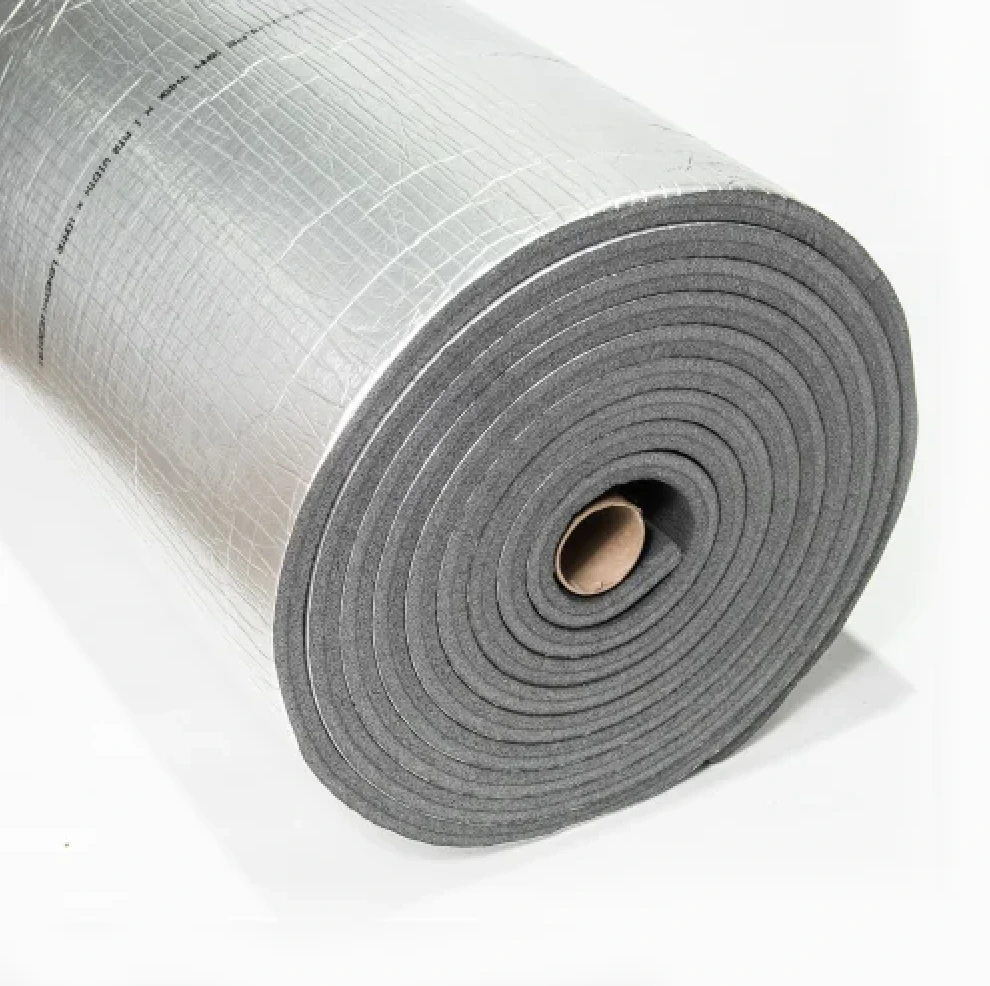
XLPE Photo from IndiMart
XLPE insulation demonstrates exceptional thermal resistance, effectively reducing heat transfer. Its cross-linked molecular structure enhances its ability to resist heat flow, providing improved insulation performance. It is durable and has a long lifespan. It exhibits resistance to aging, degradation, and environmental factors, ensuring its thermal performance remains consistent over time. XLPE insulation demonstrates excellent resistance to a wide range of chemicals, including acids, alkalis, solvents, and oils. This makes it a suitable choice for applications where exposure to chemicals is anticipated, ensuring the insulation’s performance and integrity are preserved in such environments.
In summary, XLPE insulation offers several heat-related benefits, including excellent thermal resistance, durability, moisture resistance, chemical resistance, low dielectric loss, and a wide range of applications.
Fiberglass
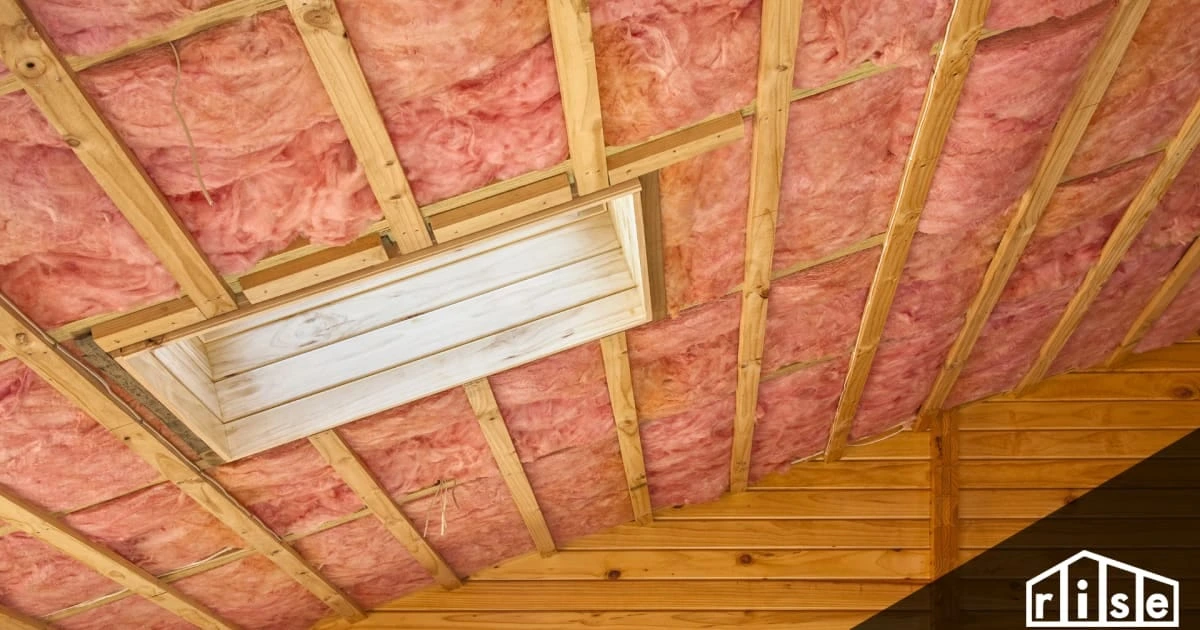
Fiberglass Photo from Build with Rise
Fiberglass insulation is known for its excellent thermal insulating properties. It is composed of fine glass fibers that create a layer of trapped air pockets. This structure slows down heat transfer through conduction, reducing heat loss in winter and heat gain in summer. Fiberglass insulation helps to create a more comfortable and energy-efficient indoor environment by maintaining consistent temperatures. Its thermal insulation properties help to lower heating and cooling costs, potentially resulting in long-term savings.
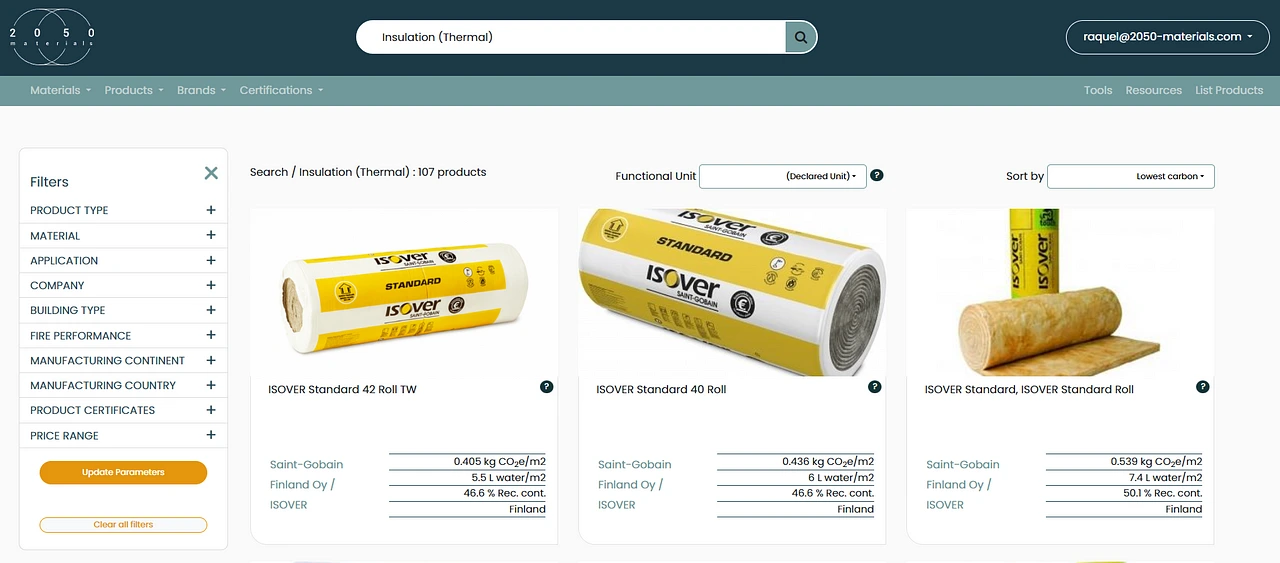
Fiberglass products on app.2050 Materials.com
Radiant Barrier- Bubble insulation

Radiant Barrier — Bubble Photo from amazon
When comparing bubble insulation to other insulation products, it emerges as a cost-effective alternative. With a remarkable 96% reflectivity, bubble insulation effectively reduces radiant heat gains within structures, resulting in a cooler and more comfortable interior environment. By blocking radiant heat transfer, Radiant Barrier-Bubble insulation reduces the amount of heat that enters or escapes the building, depending on the climate. The reduced heat gain or loss achieved with Radiant Barrier-Bubble insulation lessens the workload on heating, ventilation, and air conditioning (HVAC) systems. This can result in improved HVAC system efficiency, as the equipment doesn’t have to work as hard to maintain desired temperatures. It can lead to potential energy savings and extended lifespan of the HVAC equipment.
Bubble Insulation delivers efficient thermal performance, making it one of the preferred choices in the insulation industry.
Extruded Polystyrene Foams (XPS)
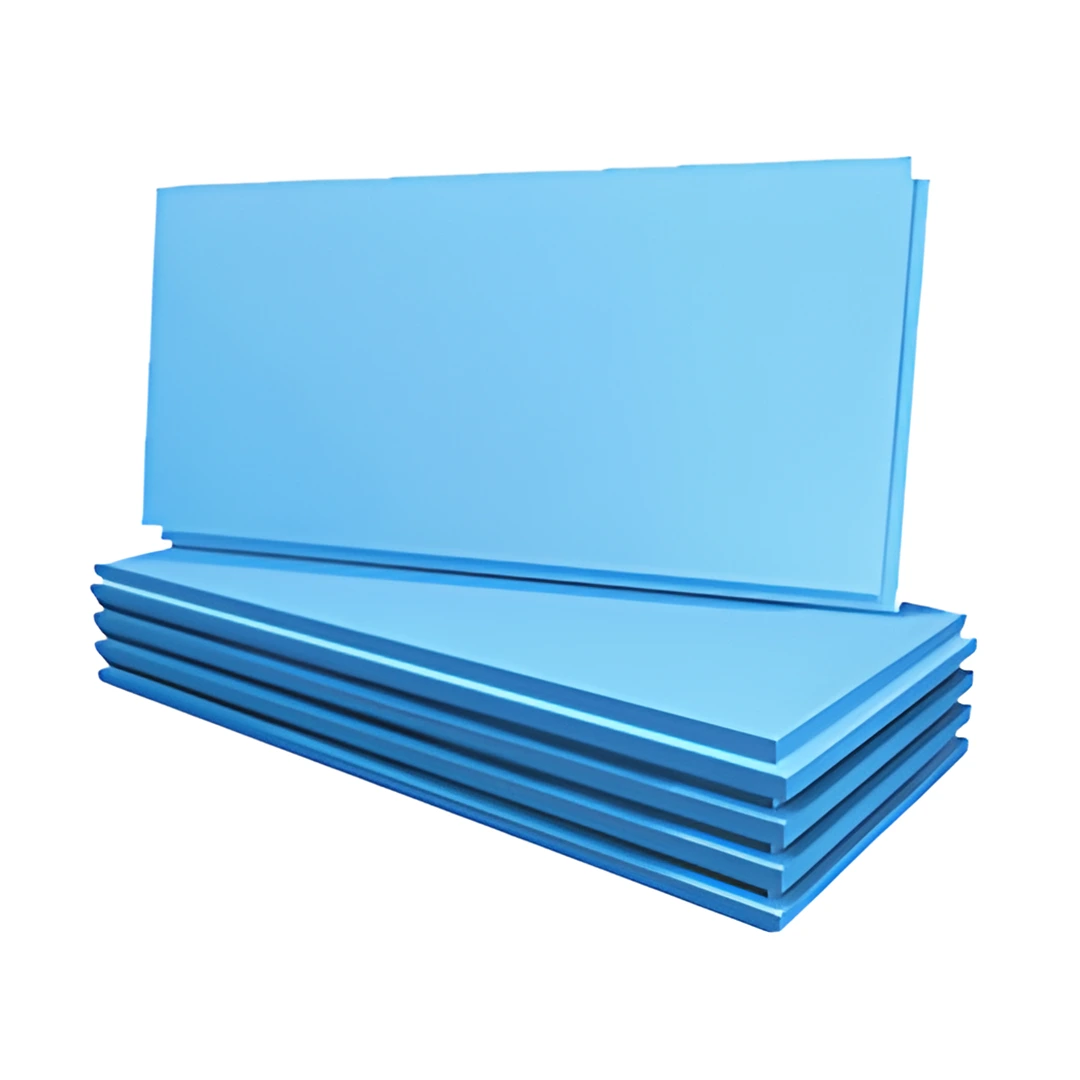
XPS Photo from Mega Insulation
XPS foams possess excellent thermal resistance properties, effectively inhibiting heat transfer. Their closed-cell structure which makes them highly resistant to moisture absorption — and low thermal conductivity minimize the flow of heat, providing superior insulation against both hot and cold temperatures. By minimizing thermal bridging and reducing conductive heat transfer, XPS foams help maintain consistent indoor temperatures. They create a thermal barrier, preventing heat loss during winter and heat gain during summer, leading to energy savings and enhanced comfort. XPS foams are also known for their strength and durability. They can withstand heavy loads, making them suitable for various applications such as roofs, walls, and foundations. Their long lifespan ensures sustained thermal performance, contributing to energy efficiency over the life of the building.
Finally, XPS foams can be easily integrated with other building materials. They can be used in combination with different wall systems, roofing materials, and insulation products to create comprehensive thermal envelopes that optimize energy efficiency and heat resistance.
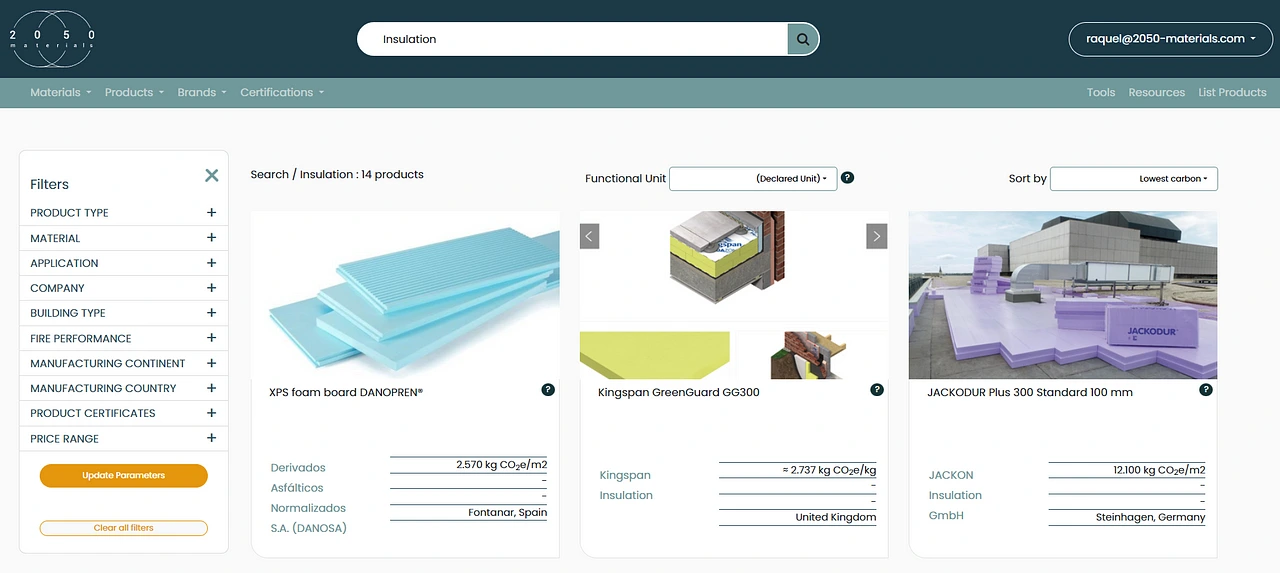
XPS Foam Board products on app.2050 Materials.com
Rockwool Insulation

Rockwool Photo from iStockphoto
One of the key advantages of Rockwool Insulation is its exceptional fire resistance. It is non-combustible and can withstand high temperatures without melting or releasing toxic gases. This property enhances the safety of the building and provides an additional layer of protection against fire hazards.
Rockwool Insulation is moisture-resistant, as it repels water and does not promote the growth of mold or mildew. This helps to maintain the insulation’s thermal performance over time and ensures a healthy indoor environment by preventing moisture-related issues. It is also known for its durability and long lifespan. It does not sag, settle, or degrade over time, providing sustained thermal performance throughout the building’s life. Its robustness allows it to withstand compression and maintain its insulating properties even under heavy loads.
It is worth noting that Rockwool Insulation is made from natural and abundant resources, primarily basalt rock and recycled materials. It is a sustainable choice that can contribute to green building practices.
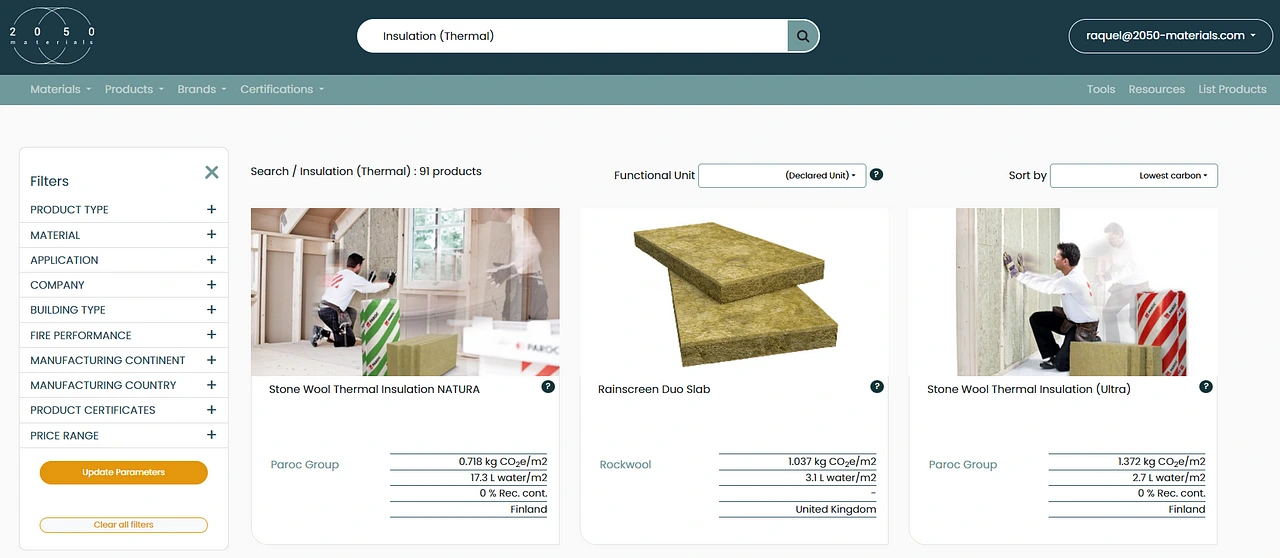
RockWool products on app.2050-materials.com
Cellulose
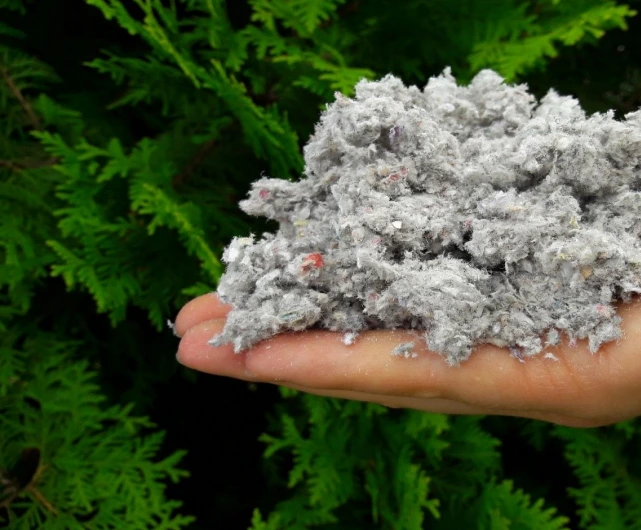
Cellulose Photo from 2050 Materials
Cellulose insulation offers excellent thermal resistance, helping to minimize heat transfer. It is primarily composed of recycled paper fibers, which create a dense and fibrous structure that effectively slows down the movement of heat. This enhances energy efficiency by reducing heat loss in winter and heat gain in summer. It can be densely packed into wall cavities, attics, and other spaces, creating an effective air barrier which helps to prevent air leakage and infiltration, reducing drafts and improving overall insulation performance. By sealing gaps and cracks, cellulose insulation enhances the building’s ability to maintain a consistent temperature. It also has the ability to absorb and release moisture, helping to regulate humidity levels within the building. It can absorb and buffer excess moisture, preventing condensation and mold growth. This moisture control feature contributes to a healthier indoor environment and protects against potential damage to the structure.
Since Cellulose insulation is treated with fire-retardant additives, such as boric acid or ammonium sulfate, during the manufacturing process, it makes the cellulose inherently fire-resistant, providing an added layer of fire protection to the building. In case of a fire, cellulose insulation can help slow down the spread of flames and reduce damage
You can explore the different products under cellulose on 2050 Materials here.
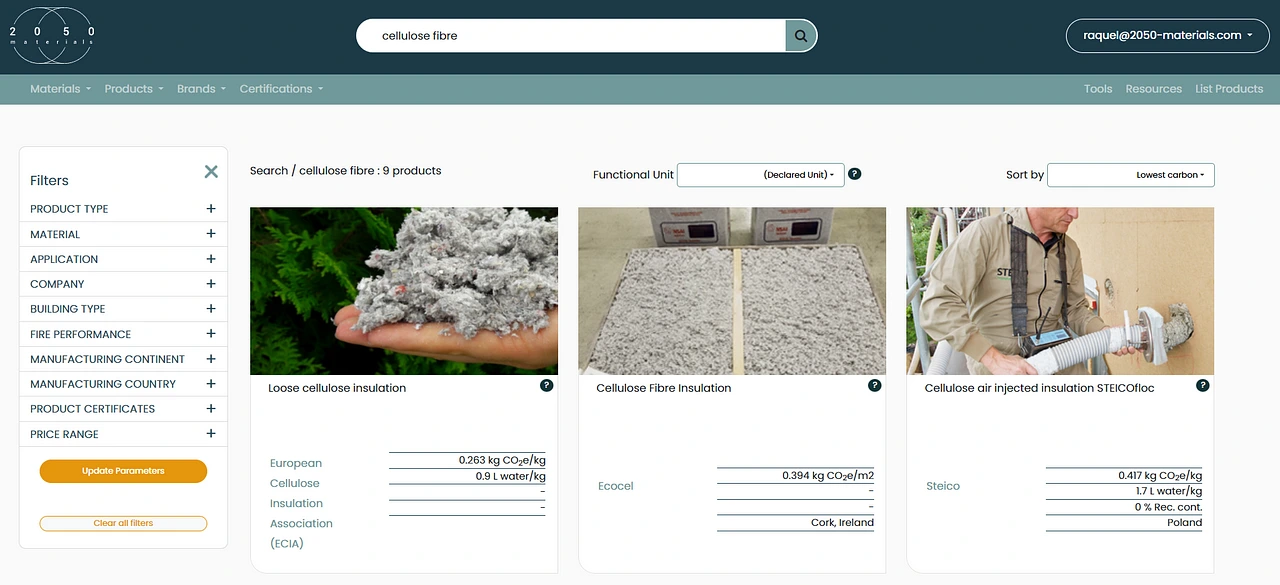
Cellulose products on app.2050-materials.com
Methods to Improve Insulation Effect in Hot Climates
By using these suggestions, you can increase their impact if your building is well-insulated.
50 Shades of Sun ☀️
To lessen the impact of the sun’s glare, cover the windows with shades, drapes, or reflecting material.
Ventilation & Co 🌬️
Turn off the heat-producing, unneeded electronics. Allow sufficient airflow throughout the structures. To ensure optimal air circulation, have adequate ventilation and open all windows at night.
Roses are red, roofs are white 🏡
Most of the radiation is reflected away from the home by roofs with light colors. The usage of a radiant barriers to reflect the heat away is one way to beat the summer heat.
L is for Location 📍
While just increasing the amount of insulation in a structure won’t always result in significant efficiency gains, doing it in the proper places can. Moving the attic insulation such that the air conditioning ducts are inside the insulated envelope is one of the best things you can do. As a result, the air conditioning units need to work less hard because less energy is lost through the ducts. You can imagine how much of the cooling is wasted before it ever reaches your rooms if an air conditioning duct runs through the hot attic. Uninsulated attics in hot, humid areas can easily reach 140° and more.
Why Summer is the Best Time to Insulate External Walls 🌴
The optimal times to complete a large-scale project, such external wall insulation, are in the spring and summer. It is the ideal time to insulate the structure of the property, not only because it gives the contractor favorable weather conditions so that the job can be finished quickly. The property has plenty of time to dry and enable any interstitial moisture to drain over the drier, warmer months, leaving the external substrate in fine condition for the works to start.
Bid Adieu to Bad Insulation with 2050 Materials
In warm temperatures, insulation is crucial. In addition to insulating the building from outside heat, it also lowers your energy usage. You’ll use less AC, which will enable you to make significant financial savings. A wall or roof with poor insulation is cooler in the winter and hotter in the summer. To safeguard your building, improve your comfort and be good to the environment, good thermal insulation is a must.
In order to help you find good insulation with low emissions, we wounded up the full range of insulation materials on 2050 Materials here.
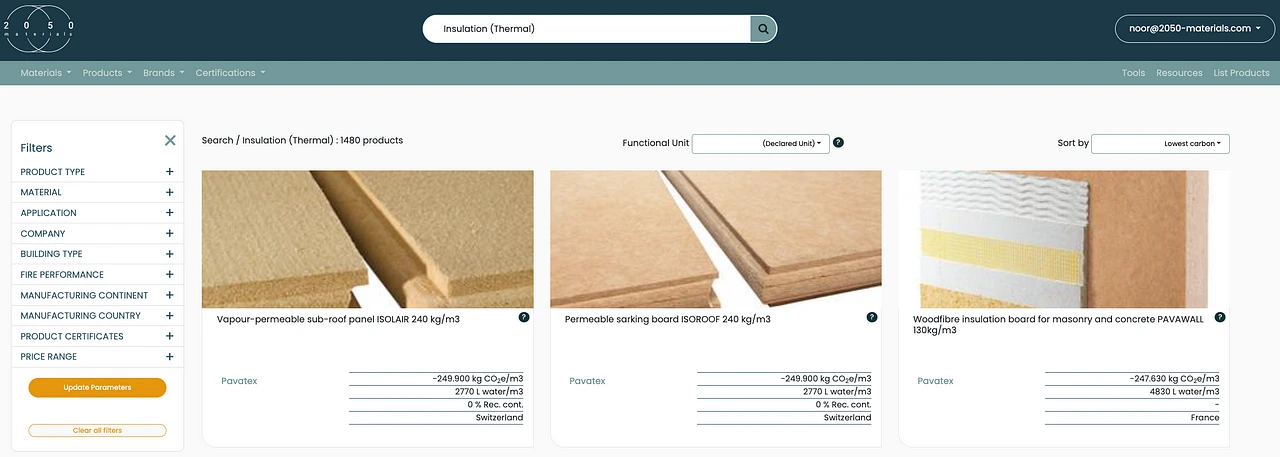
Thermal Insulation — Full Range on 2050 Materials
If you are working on specifying thermal insulation materials, count on 2050 Materials support and educational contents. We will help you compile a suitable list of products and suppliers that best fit your project’s requirements. Our free-to-use 2050 Materials library offers a wide range of innovative, low-impact, and healthy materials in the market worldwide.
Get your high-quality printable “Illustrated Guide to Insulation Materials” designed by the 2050 Materials team for architects and designers aiming to navigate the sustainable building landscape.
Sources:
Thermal Insulation for Hot Climates: https://vietec.co/thermalinsulation/
Does External Wall Insulation Work in the Summer: https://www.beconstructiveltd.com/does-insulation-work-in-summer/
Insulation Tips for Hot, Humid Climates: https://www.heimsath.com/blog-0/bid/40040/energy-efficient-design-3-insulation-tips-for-hot-humid-climates
The 5 common Thermal Insulation materials https://www.barbourproductsearch.info/the-5-common-thermal-insulation-materials-blog000424.html
More on thermal insulation here.
Related articles

Climate-Resilient Materials for the Built Environment: A Data-Centred Prime
As climate volatility intensifies, resilience metrics are fast becoming as critical as carbon data in material selection. This article outlines why adaptation is now a design imperative, how materials can be evaluated through a systems lens, and what KPIs project teams should demand. From self-healing concrete to fire-rated façades, we present a structured taxonomy of resilient materials, explain how to embed this intelligence into digital design workflows, and propose next steps for specification, benchmarking, and procurement.
Read more
The Most Interesting Low Carbon Products in Office Design
In this article and collection, we highlight 11 outstanding products that contribute to a lower carbon footprint in office design.
Read more
Top Low Carbon Building Boards: Performance, Benefits, and Use Cases
The building boards highlighted in this article and collection showcase low-carbon innovation in modern construction.
Read more